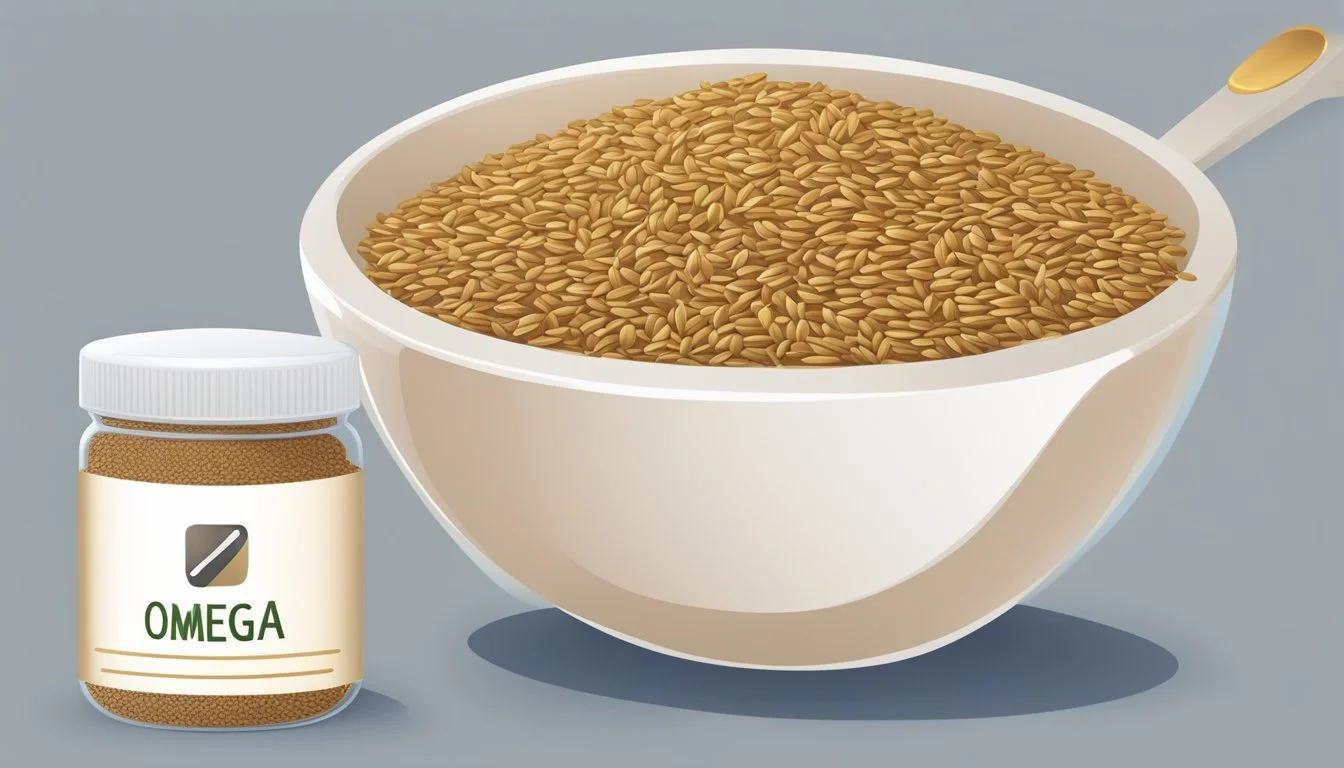How Much Flaxseed to Consume Daily for Optimal Omega-3 Intake
Flaxseed is a nutrient-dense superfood, recognized primarily for its rich omega-3 fatty acid content, specifically alpha-linolenic acid (ALA). These essential fatty acids are known for their role in maintaining heart health, reducing inflammation, and supporting brain function. Unlike the omega-3 fatty acids found in fish oil, which are in the form of eicosapentaenoic acid (EPA) and docosahexaenoic acid (DHA), flaxseed provides ALA, which the body can partially convert to EPA and DHA.
The consumption of flaxseed contributes to the intake of fiber, protein, and lignans, which are phytochemicals that may help in lowering the risk of chronic illnesses. Health experts often recommend ground flaxseed over whole flaxseed due to its improved digestibility, which allows the body to access the nutrients more effectively. For adults, a daily intake of one to two tablespoons of ground flaxseed is generally considered sufficient to provide the health benefits associated with omega-3 fatty acids.
Incorporating flaxseed into a balanced diet is relatively simple, with its mild, nutty flavor making it a versatile addition to many foods such as smoothies, oatmeal, and baked goods. By doing so, individuals can easily meet the recommended daily doses of omega-3 ALA and gain the associated health benefits. To achieve optimal health outcomes, it is crucial to consider individual nutritional needs and consult healthcare providers for personalized dietary advice.
Understanding Omega-3 Fatty Acids
Omega-3 fatty acids are crucial components of cell membranes throughout the body and affect the function of the cell receptors in these membranes. They provide the starting point for making hormones that regulate blood clotting, contraction and relaxation of artery walls, and inflammation.
Definition and Types
Omega-3 fatty acids are a group of polyunsaturated fatty acids crucial to human health. There are three main types:
Alpha-linolenic acid (ALA): Found mainly in plant oils.
Eicosapentaenoic acid (EPA): Commonly found in fish and fish oil.
Docosahexaenoic acid (DHA): Also primarily found in fish and fish oil.
These fatty acids are essential, meaning the body cannot produce them and must obtain them through diet.
Sources of Omega-3
Omega-3 fatty acids are found in a variety of foods. Here's a list of some common sources:
Fish and Fish Oil: Rich in EPA and DHA.
Plant Oils: Such as flaxseed, soybean, and canola oil, which contain ALA.
Seeds and Nuts: Chia seeds and walnuts are good sources of ALA.
Flaxseed: Both flaxseed oil and ground flaxseed are excellent sources of ALA.
ALA, EPA, and DHA Comparison
While all omega-3 fatty acids are beneficial, their effects in the body differ.
ALA: It is the most common omega-3 fatty acid in Western diets. The body partially converts ALA to EPA and DHA, although the conversion rate is low.
EPA: Known for its role in reducing inflammation, supporting heart health, and contributing to brain function.
DHA: Important for brain development and function. High levels are found in the retina, sperm cells, and cerebral cortex.
Incorporating various sources of omega-3s into the diet is important for maintaining a balance between these essential nutrients.
Health Benefits of Omega-3
Omega-3 fatty acids are essential fats that provide various health benefits, particularly for heart health, cancer prevention, reducing inflammation, and supporting brain and vision health.
Heart Health
Omega-3 fatty acids are recognized for their role in maintaining heart health. They can help reduce levels of triglycerides, a type of fat in the blood, which, in high levels, is associated with an increased risk of heart disease. Furthermore, omega-3s aid in lowering blood pressure and can improve the health of blood vessels, reducing the likelihood of cardiovascular disease.
Cancer Prevention
Research has indicated that omega-3 fatty acids may be beneficial in cancer prevention. They have been linked to a lower risk of cancers, including breast cancer. These fatty acids might inhibit cancer cell growth and induce apoptosis, which is the process of programmed cell death in potentially malignant cells.
Anti-Inflammatory Effects
Omega-3s have potent anti-inflammatory properties, which are crucial in reducing the risk of chronic diseases. They support the body's ability to reduce inflammation, which is beneficial for conditions like arthritis and may also improve outcomes in individuals with inflammatory bowel diseases.
Mental and Vision Health
The components of omega-3 fatty acids, EPA and DHA, are vital for brain health and cognitive function. They have been associated with a lower risk of mental decline and may support overall brain health. Moreover, DHA is a major structural component of the retina, implying that these fatty acids are important for vision and the prevention of macular degeneration.
Flaxseed as a Nutritional Powerhouse
Flaxseed stands out for its high omega-3 fatty acid content, but it also provides an array of other essential nutrients. They contribute significantly to a balanced diet, offering substantial amounts of fiber, lignans, protein, and various micronutrients.
Fiber Content
Flaxseed is an excellent source of fiber, containing both soluble and insoluble types. Every tablespoon of ground flaxseed packs about 2 grams of dietary fiber. Soluble fiber aids in maintaining healthy blood sugar and cholesterol levels, while insoluble fiber promotes regular bowel movements and digestive health.
Lignans and Antioxidants
Rich in lignans, which are a type of polyphenol, flaxseeds are known for their antioxidant properties. These compounds may provide protective effects against certain types of cancer and also support heart health. In fact, flaxseeds contain about a hundred times more lignans than other plant foods.
Protein and Nutrient Profile
Flaxseed is a good source of plant-based protein, contributing to the maintenance and repair of the body's tissues. Additionally, it contains a spectrum of essential nutrients, such as thiamine and copper. This nutrient profile supports various bodily functions including metabolism and enzyme function.
Recommended Intake of Flaxseed
The intake of flaxseed can provide a substantial amount of omega-3 fatty acids, which are essential to heart health. Establishing the right dosage is important and varies by individual needs and recommendations from health organizations.
Daily Dosage for Omega-3
For the general adult population, it is often recommended to consume approximately 1 to 2 tablespoons of ground flaxseed per day. This amount typically yields about 1.6 grams of omega-3 fatty acids, aligning with daily requirements.
Infants (Birth to 12 months): Not established
Children (1-3 years): 0.7 grams
Children (4-8 years): 0.9 grams
Boys (9-13 years): 1.2 grams
Girls (9-13 years): 1 gram
Teenage Boys (14-18 years): 1.6 grams
Teenage Girls (14-18 years): 1.1 grams
Men (19+ years): 1.6 grams
Women (19+ years): 1.1 grams
Adjusting for Age and Health
Pregnant/Breastfeeding Women: Requirements for omega-3 fatty acids increase in pregnant or breastfeeding women. It's advisable for them to seek guidance from their healthcare provider.
Older Adults: May need higher intake due to absorption issues or increased need for omega-3s.
Guidelines from Health Organizations
American Heart Association:
Heart Health: At least two servings of omega-3 rich foods like flaxseed per week.
It's essential for individuals to consult their healthcare provider to determine their specific needs based on their health status and dietary requirements.
Incorporating Flaxseed into Your Diet
To capitalize on the omega-3 fatty acids in flaxseed, one can incorporate it into their diet in various forms, each suitable for blending into different recipes and meals.
Different Forms of Flaxseed
Ground flaxseed is widely recognized for its versatility and is better absorbed by the body than whole flaxseed. It can be used directly in recipes or as a nutritional supplement. Flaxseed oil provides a concentrated source of omega-3 fatty acids and is best used as a dressing or in cold applications, since it is sensitive to heat.
Ground Flaxseed: Easily mixed into foods; retains nutrients upon cooking.
Flaxseed Oil: Best for no-cook dishes; should be stored in a cool, dark place to maintain its integrity.
Creative Recipe Ideas
Incorporating flaxseed into one’s diet can be creative and enjoyable. They can start by adding ground flaxseed to their morning smoothie for a nutrient-rich start to the day. Experimenting with flaxseed-based sauces or using it as a thickener can also provide a nutritious boost. Here are some quick inspirations:
Smoothies: Blend 1 tablespoon into your favorite fruits and veggies.
Baked Goods: Substitute ground flaxseed for part of the flour in recipes for breads, muffins, and cookies.
Pairing with Other Foods
Flaxseed, in its various forms, pairs well with an array of foods enhancing their nutritional profiles. Adding ground flaxseed to yogurt increases its fiber content, while a sprinkle on top of a salad can add a pleasant nutty flavor. Here’s a brief pairing guide:
Yogurt: Mix in 1 tablespoon of ground flaxseed.
Salad: Top your greens with a teaspoon of flaxseed oil for an omega-3 boost without altering the taste drastically.
Potential Health Risks and Considerations
While flaxseed is a beneficial source of omega-3 fatty acids, it is important to be aware of potential health risks and considerations when including it in one's diet. Consumers should be mindful of side effects, interactions with medications, and concerns for specific populations.
Dealing with Side Effects
Side effects are generally minimal but may include gastrointestinal issues such as bloating, gas, or diarrhea, particularly if one consumes too much flaxseed without gradually increasing the intake. To minimize side effects, it is crucial to:
Start with a small dose and gradually increase.
Ensure adequate water intake to help fiber expansion and digestion.
Interactions with Medications
Certain medications can interact with flaxseed, notably blood thinners and drugs that affect blood clotting. Flaxseed's high fiber content can also impact medication absorption. Key considerations:
Consult a healthcare provider before combining flaxseed with blood thinners.
Separate flaxseed intake from medication times to prevent absorption issues.
Concerns for Specific Populations
Flaxseed may exert phytoestrogenic effects, influencing menopausal symptoms. However, its impact can vary, and it’s advisable for those experiencing menopause to consult with healthcare professionals prior to use. Flaxseed should be approached with caution for populations including:
Pregnant women: Due to potential hormonal effects, they should seek medical advice before consumption.
Breastfeeding mothers: While typically safe, it's best to confirm with a healthcare provider.
Prostate health: Studies have presented mixed results on flaxseed's influence on the prostate. Monitoring and clinical guidance are recommended.
Individuals with allergic reactions to flaxseed should avoid consumption entirely.
Comparative Analysis: Flaxseed versus Other Omega-3 Sources
In evaluating different sources of omega-3 fatty acids, it's important to understand the types of omega-3s provided by each source and how effectively the body can utilize them.
Fish and Fish Oil Supplements
Fish and fish oil supplements are rich in eicosapentaenoic acid (EPA) and docosahexaenoic acid (DHA), omega-3 fatty acids that are readily used by the body. A tablespoon of fish oil typically contains much higher levels of these long-chain omega-3s compared to plant-based sources. Fish such as salmon, mackerel, and sardines are natural sources that also offer additional nutrients like protein and vitamin D.
Plant-based Alternatives
Flaxseed is a notable plant-based source of alpha-linolenic acid (ALA), a short-chain omega-3 fatty acid. The body converts ALA to EPA and DHA, albeit at a lower conversion rate than when these nutrients are consumed directly from fish. Other plant sources like chia seeds and walnuts also contain ALA, offering a variety of options for individuals preferring plant-based nutrition.
Efficiency of Omega-3 Absorption
The body's efficiency in converting ALA from sources such as flaxseed into EPA and DHA varies, with supplements often designed to aid this process. However, directly ingested EPA and DHA from fish or fish oil have a higher rate of absorption in the body. This makes fish a more direct and efficient way to increase one's omega-3 index compared to plant-based alternatives.
Flaxseed and Overall Wellness
Consuming flaxseed contributes to overall wellness through its positive effects on digestive health, blood sugar regulation, and weight management. It provides essential nutrients that support various body functions.
Contributions to Digestive Health
Flaxseed is a rich source of dietary fiber, essential for maintaining gut health. Specifically, it contains both soluble and insoluble fibers. Soluble fiber aids in stool formation, while insoluble fiber helps increase the weight and size of the stool, facilitating its passage through the digestive tract. This dual action helps to promote regular bowel movements and prevent constipation.
Influence on Blood Sugar and Diabetes
Individuals with type 2 diabetes or those managing blood sugar levels can benefit from the inclusion of flaxseed in their diet. The fiber in flaxseed can help slow down the release of sugar into the bloodstream, contributing to more stable blood sugar levels. Moreover, the alpha-linolenic acid (ALA) present in flaxseed might improve insulin sensitivity, which can help in managing metabolic syndrome.
Role in Weight Management and Energy
The high fiber content of flaxseed also contributes to weight management by promoting a feeling of fullness which may lead to reduced calorie intake. Additionally, flaxseed contains protein and omega-3 fatty acids, providing a steady source of energy while supporting cell function. Managing calorie intake and ensuring adequate energy levels are crucial components of a sustainable weight management plan.





